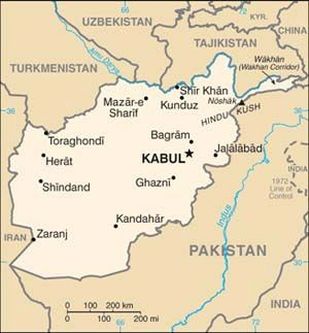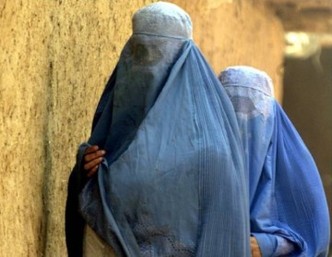This is Rachel's By the Taliban page
The Taliban’s Treatment of Women
In the 1980’s the Taliban drew world attention as a band of
Pashtun tribesmen who grouped together to fight off the Soviet invasion of
Afghanistan. Although the Soviets were on friendly terms with the Afghans at
first and tried to bring an end to the civil war taking place, bonds quickly
grew strained as people began to grow tired of the Soviets dictating the
country’s rule and the imprisoning the Afghan people. It is estimated that they
killed an estimated 80,000 people during their purges. During this time women
were a very visible part of Afghan society, especially the educational system.
In fact 70 percent of teachers in the capital of Kabul were women (pbs.org).
While women didn’t enjoy all the same rights as men, they were a large part of
society and were not have to wear the infamous burkas. If the women wore them
it was by their own choosing. The Taliban never approved of women being an
active part of society and believed that women should be kept off the streets
because they were property of their fathers, husbands or brothers.
On September 27, 1996 the Taliban hung the ruler at that time,
Najibullah, as well as his brother and assumed absolute power over the capital
city, Kabul. In her touching memoir, My Forbidden Face, Latifa (a pseudo
name to protect her identity), recounts how her clothing changed on that
September day, “I usually wear sweatpants, a polo shirt or pullover, and running
shoes, but today I dress prudently in a long dress and chadors…” (Latifa 9). The
entire goal of the Taliban was to take over Afghanistan and implement a strict
and extreme interpretation of the Koran and Islam in general. They were
specifically focused on demeaning women for religion’s sake which led to a
series of edicts determining what women could and could not do.
Some of the edicts the Taliban created in the next few years
included:
*Women and girls were not allowed to work outside the
home.
*All women planning on leaving the home had to be accompanied by their father, brother
or husband.
*Public transportation had separate buses for men and
women.
*Women and girls had to wear a chadri and could not wear brightly colored clothes
underneath.
*It was forbidden to wear makeup or nail polish.
*A girl was not allowed to talk to a young man. If this was broken an immediate
marriage between the two was mandatory.
*No male doctor could touch the body of a woman under the pretext of an examination.
*Merchants were forbidden to sell female undergarments.
*Girls were not allowed to be educated in the public school system and women were not
allowed to teach. (stategov.com)
The list goes on until almost every single aspect of the
peoples’ lives is depicted for them. Women went from having many freedoms to
being completely locked up. Latifa writes in her memoir, “This time, they’re
really killing us, killing all girls and women. They’re killing us stealthily,
in silence… Women, go home! Or disappear under the chadri, out of the sight of
men. It’s an absolute denial of individual liberty, a real sexual racism…”
(Latifa 38). Perhaps the most devastating of these edicts was the ban of
education for girls which caused many women to start private schooling inside
their homes. The Taliban soon found out about these and on June 16, 1998 the
Taliban shut down 100 private schools in Kabul and women’s literacy rates fell
across the country until they were the lowest in the world with only 13% in
urban areas and 3% to 4% in rural areas. (pbs.com)
Members of the Taliban would also beat and rape the women of their choosing and
no punishment was declareed for these awful acts of violence. Many women's entire
lives and reputations were ruined because of the Taliban's brutality.
*Here is a video that was made by some students that did a research project for school on the taliban's treatment of women. This video could not be used as a valid source, however reputable sources do in fact validate the information shown in this video. http://www.youtube.com/watch?v=emMrn9ja5iU&feature=related
Sources
A Woman Among Warlords ~ Women’s Rights in the Taliban and Post-Taliban Eras | Wide Angle|PBS." PBS: Public Broadcasting Service. Thirteen, 11 Sept. 2007. Web. 27 Sept. 2011.
<http://www.pbs.org/wnet/wideangle/episodes/a-woman-among-warlords/womens-rights-in-the-taliban- and-post-taliban-eras/66/>.
Afghanistan." U.S. Department of State. Bureau of South and Central Asian Affairs,
6 Dec. 2010. Web. 27 Sept. 2011.
<http://www.state.gov/r/pa/ei/bgn/5380.htm>.
Bruno, Greg, and Eben Kaplan. "The Taliban in Afghanistan."
Council on Foreign Relations. 3 Aug. 2009. Web. 27 Sept. 2011.
<http://www.cfr.org/afghanistan/taliban-afghanistan/p10551>.
Latifa. My Forbidden Face: Growing up under the Taliban: a Young
Woman's Story. Ed. Karenna Gore Schiff. New York: Hyperion, 2001.
Print.
Pashtun tribesmen who grouped together to fight off the Soviet invasion of
Afghanistan. Although the Soviets were on friendly terms with the Afghans at
first and tried to bring an end to the civil war taking place, bonds quickly
grew strained as people began to grow tired of the Soviets dictating the
country’s rule and the imprisoning the Afghan people. It is estimated that they
killed an estimated 80,000 people during their purges. During this time women
were a very visible part of Afghan society, especially the educational system.
In fact 70 percent of teachers in the capital of Kabul were women (pbs.org).
While women didn’t enjoy all the same rights as men, they were a large part of
society and were not have to wear the infamous burkas. If the women wore them
it was by their own choosing. The Taliban never approved of women being an
active part of society and believed that women should be kept off the streets
because they were property of their fathers, husbands or brothers.
On September 27, 1996 the Taliban hung the ruler at that time,
Najibullah, as well as his brother and assumed absolute power over the capital
city, Kabul. In her touching memoir, My Forbidden Face, Latifa (a pseudo
name to protect her identity), recounts how her clothing changed on that
September day, “I usually wear sweatpants, a polo shirt or pullover, and running
shoes, but today I dress prudently in a long dress and chadors…” (Latifa 9). The
entire goal of the Taliban was to take over Afghanistan and implement a strict
and extreme interpretation of the Koran and Islam in general. They were
specifically focused on demeaning women for religion’s sake which led to a
series of edicts determining what women could and could not do.
Some of the edicts the Taliban created in the next few years
included:
*Women and girls were not allowed to work outside the
home.
*All women planning on leaving the home had to be accompanied by their father, brother
or husband.
*Public transportation had separate buses for men and
women.
*Women and girls had to wear a chadri and could not wear brightly colored clothes
underneath.
*It was forbidden to wear makeup or nail polish.
*A girl was not allowed to talk to a young man. If this was broken an immediate
marriage between the two was mandatory.
*No male doctor could touch the body of a woman under the pretext of an examination.
*Merchants were forbidden to sell female undergarments.
*Girls were not allowed to be educated in the public school system and women were not
allowed to teach. (stategov.com)
The list goes on until almost every single aspect of the
peoples’ lives is depicted for them. Women went from having many freedoms to
being completely locked up. Latifa writes in her memoir, “This time, they’re
really killing us, killing all girls and women. They’re killing us stealthily,
in silence… Women, go home! Or disappear under the chadri, out of the sight of
men. It’s an absolute denial of individual liberty, a real sexual racism…”
(Latifa 38). Perhaps the most devastating of these edicts was the ban of
education for girls which caused many women to start private schooling inside
their homes. The Taliban soon found out about these and on June 16, 1998 the
Taliban shut down 100 private schools in Kabul and women’s literacy rates fell
across the country until they were the lowest in the world with only 13% in
urban areas and 3% to 4% in rural areas. (pbs.com)
Members of the Taliban would also beat and rape the women of their choosing and
no punishment was declareed for these awful acts of violence. Many women's entire
lives and reputations were ruined because of the Taliban's brutality.
*Here is a video that was made by some students that did a research project for school on the taliban's treatment of women. This video could not be used as a valid source, however reputable sources do in fact validate the information shown in this video. http://www.youtube.com/watch?v=emMrn9ja5iU&feature=related
Sources
A Woman Among Warlords ~ Women’s Rights in the Taliban and Post-Taliban Eras | Wide Angle|PBS." PBS: Public Broadcasting Service. Thirteen, 11 Sept. 2007. Web. 27 Sept. 2011.
<http://www.pbs.org/wnet/wideangle/episodes/a-woman-among-warlords/womens-rights-in-the-taliban- and-post-taliban-eras/66/>.
Afghanistan." U.S. Department of State. Bureau of South and Central Asian Affairs,
6 Dec. 2010. Web. 27 Sept. 2011.
<http://www.state.gov/r/pa/ei/bgn/5380.htm>.
Bruno, Greg, and Eben Kaplan. "The Taliban in Afghanistan."
Council on Foreign Relations. 3 Aug. 2009. Web. 27 Sept. 2011.
<http://www.cfr.org/afghanistan/taliban-afghanistan/p10551>.
Latifa. My Forbidden Face: Growing up under the Taliban: a Young
Woman's Story. Ed. Karenna Gore Schiff. New York: Hyperion, 2001.
Print.


